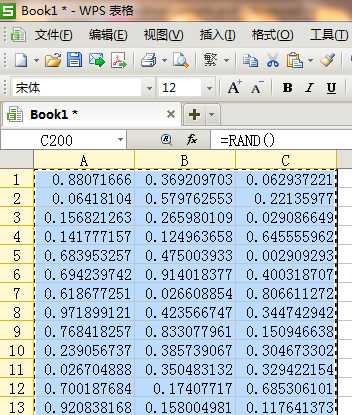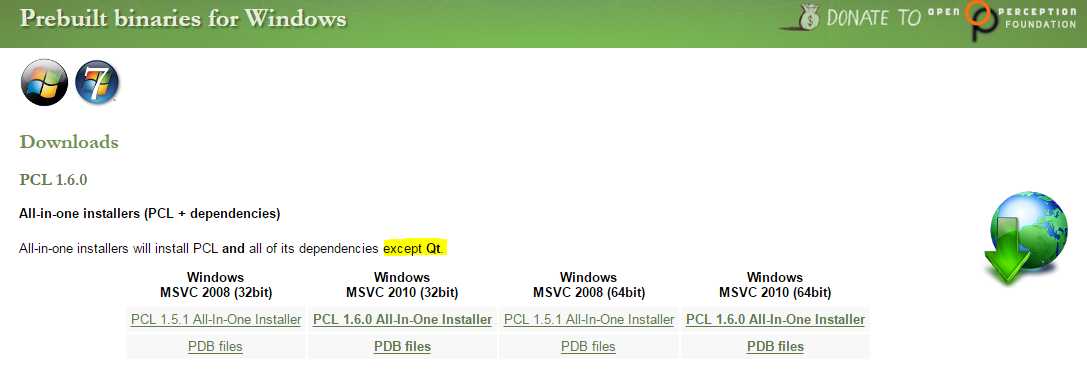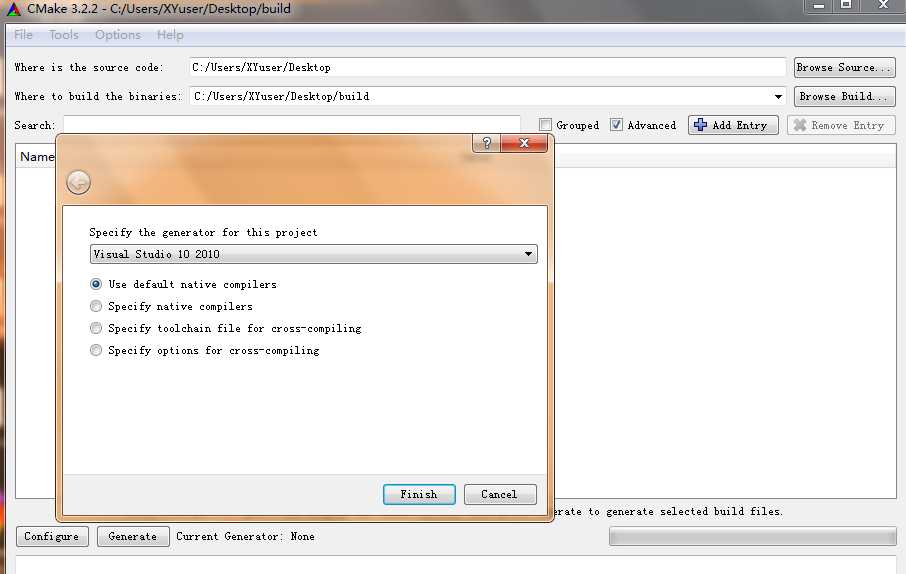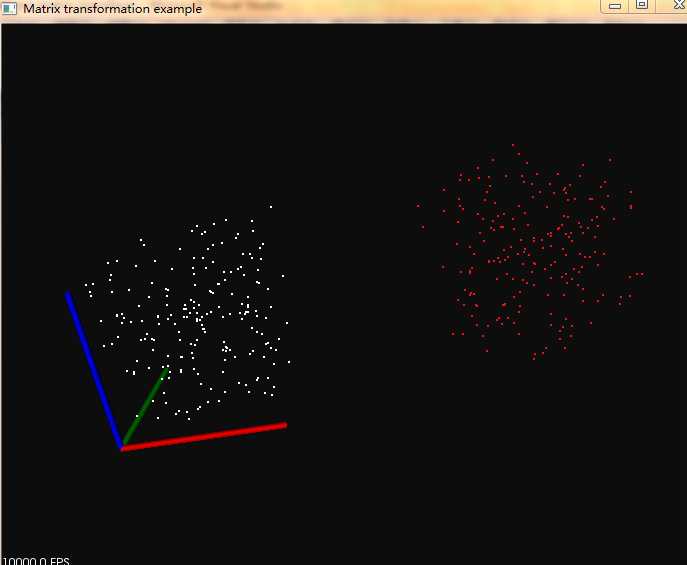标签:npoi origin key get 文件夹 load ota min http
点云数据可以用ASCII码的形式存储在PCD文件中(关于该格式的描述可以参考链接:The PCD (Point Cloud Data) file format)。为了生成三维点云数据,在excel中用rand()函数生成200行0-1的小数,ABC三列分别代表空间点的xyz坐标。

# .PCD v.7 - Point Cloud Data file format VERSION .7 FIELDS x y z SIZE 4 4 4 TYPE F F F COUNT 1 1 1 WIDTH 200 HEIGHT 1 VIEWPOINT 0 0 0 1 0 0 0 POINTS 200 DATA ascii 0.88071666 0.369209703 0.062937221 0.06418104 0.579762553 0.221359779 ... ... 0.640053058 0.480279041 0.843647334 0.245554712 0.825770496 0.626442137
进行点云的变换主要用到的函数是pcl::transformPointCloud,函数原型为:
void pcl::transformPointCloud(const pcl::PointCloud< PointT > & cloud_in,
pcl::PointCloud< PointT > & cloud_out,
const Eigen::Matrix4f & transform )
参数中cloud_in为源点云,cloud_out为变换后的点云,transform为变换矩阵。下面的代码对源点云绕Z轴旋转45°,然后沿X轴平移了2.5个单位:
#include <iostream>
#include <pcl/io/pcd_io.h>
#include <pcl/point_cloud.h>
#include <pcl/common/transforms.h> //allows us to use pcl::transformPointCloud function
#include <pcl/visualization/pcl_visualizer.h>
// This is the main function
int main (int argc, char** argv)
{
//creates a PointCloud<PointXYZ> boost shared pointer and initializes it.
pcl::PointCloud<pcl::PointXYZ>::Ptr source_cloud (new pcl::PointCloud<pcl::PointXYZ> ());
// Load PCD file
if (pcl::io::loadPCDFile<pcl::PointXYZ> ("sample.pcd", *source_cloud) == -1)
{
PCL_ERROR ("Couldn‘t read file sample.pcd \n");
return (-1);
}
/* Reminder: how transformation matrices work :
|-------> This column is the translation
| 1 0 0 x | | 0 1 0 y | }-> The identity 3x3 matrix (no rotation) on the left
| 0 0 1 z | /
| 0 0 0 1 | -> We do not use this line (and it has to stay 0,0,0,1)
METHOD #1: Using a Matrix4f
This is the "manual" method, perfect to understand but error prone !
*/
Eigen::Matrix4f transform_1 = Eigen::Matrix4f::Identity();
// Define a rotation matrix (see https://en.wikipedia.org/wiki/Rotation_matrix)
// Here we defined a 45° (PI/4) rotation around the Z axis and a translation on the X axis.
float theta = M_PI/4; // The angle of rotation in radians
transform_1 (0,0) = cos (theta);
transform_1 (0,1) = -sin(theta);
transform_1 (1,0) = sin (theta);
transform_1 (1,1) = cos (theta);
// (row, column)
// Define a translation of 2.5 meters on the x axis.
transform_1 (0,3) = 2.5;
// Print the transformation
printf ("Method #1: using a Matrix4f\n");
std::cout << transform_1 << std::endl;
// Executing the transformation
pcl::PointCloud<pcl::PointXYZ>::Ptr transformed_cloud (new pcl::PointCloud<pcl::PointXYZ> ());
/*
void pcl::transformPointCloud(const pcl::PointCloud< PointT > & cloud_in,
pcl::PointCloud< PointT > & cloud_out,
const Eigen::Matrix4f & transform )
*/
// Apply an affine transform defined by an Eigen Transform.
pcl::transformPointCloud (*source_cloud, *transformed_cloud, transform_1);
// Visualization
printf( "\nPoint cloud colors : white = original point cloud\n"
" red = transformed point cloud\n");
pcl::visualization::PCLVisualizer viewer ("Matrix transformation example");
// Define R,G,B colors for the point cloud
pcl::visualization::PointCloudColorHandlerCustom<pcl::PointXYZ> source_cloud_color_handler (source_cloud, 255, 255, 255);
// We add the point cloud to the viewer and pass the color handler
viewer.addPointCloud (source_cloud, source_cloud_color_handler, "original_cloud");
pcl::visualization::PointCloudColorHandlerCustom<pcl::PointXYZ> transformed_cloud_color_handler (transformed_cloud, 230, 20, 20); // Red
viewer.addPointCloud (transformed_cloud, transformed_cloud_color_handler, "transformed_cloud");
viewer.addCoordinateSystem (1.0, 0); //Adds 3D axes describing a coordinate system to screen at 0,0,0.
viewer.setBackgroundColor(0.05, 0.05, 0.05, 0); // Setting background to a dark grey
viewer.setPointCloudRenderingProperties (pcl::visualization::PCL_VISUALIZER_POINT_SIZE, 2, "original_cloud");
viewer.setPointCloudRenderingProperties (pcl::visualization::PCL_VISUALIZER_POINT_SIZE, 2, "transformed_cloud");
//viewer.setPosition(800, 400); // Setting visualiser window position
while (!viewer.wasStopped ()) { // Display the visualiser until ‘q‘ key is pressed
viewer.spinOnce ();
}
return 0;
}
在PCL官网下载All-in-one installers,由于使用的是Win7 32位系统,因此选择了Windows MSVC 2010 (32bit)进行安装,这个All-in-one的安装程序会同时安装除QT外的一些第三方依赖库,比如boost、Eigen、VTK、OpenNI等。

安装好之后如果是自己在VS2010中配置工程属性,将会很麻烦,可以参考Using PCL in your own project。下面通过Cmake来自动生成VS2010的项目。首先创建一个CMakeLists.txt文件(注意其中PCL的版本)。如果编译软件使用了外部库,事先并不知道它的头文件和链接库的位置。得在编译命令中加上包含它们的查找路径。CMake使用find_package命令来解决这个问题。
cmake_minimum_required(VERSION 2.6 FATAL_ERROR)
project(pcl-matrix_transform)
find_package(PCL 1.6 REQUIRED)
include_directories(${PCL_INCLUDE_DIRS})
link_directories(${PCL_LIBRARY_DIRS})
add_definitions(${PCL_DEFINITIONS})
add_executable (matrix_transform matrix_transform.cpp)
target_link_libraries (matrix_transform ${PCL_LIBRARIES})
然后使用CMake的GUI程序来生成工程文件。Where is the source code栏选择源代码所在路径,这里代码放在桌面上;Where to build the binaries栏选择生成文件所在的路径,默认在桌面上的build文件夹中。点击Configure之后会弹出对话框,选择Visual Studio 2010,最后点击生成按钮,将会在build文件夹中生成VS2010的工程文件。

在编译之前需要注意一点,由于All-in-one的安装程序没有安装QT(需要单独安装),需要在工程属性的附加依赖项中删掉QT的lib(这个程序中暂时也没有用到QT相关的东西),否则会出现编译错误。最后运行程序,结果如下图所示。其中红色的点云为变换后的。

参考:
Using a matrix to transform a point cloud
http://pointclouds.org/documentation/tutorials/matrix_transform.php#matrix-transform
The PCD (Point Cloud Data) file format
http://pointclouds.org/documentation/tutorials/pcd_file_format.php#pcd-file-format
Reading Point Cloud data from PCD files
http://pointclouds.org/documentation/tutorials/reading_pcd.php#reading-pcd
PCL学习笔记(1):pcl1.6.0+vs2010环境配置以及第一个pcl程序
http://www.voidcn.com/blog/chentravelling/article/p-3487308.html
PCL点云库:对点云进行变换(Using a matrix to transform a point cloud)
标签:npoi origin key get 文件夹 load ota min http
原文地址:https://www.cnblogs.com/wwwbdabc/p/11653314.html